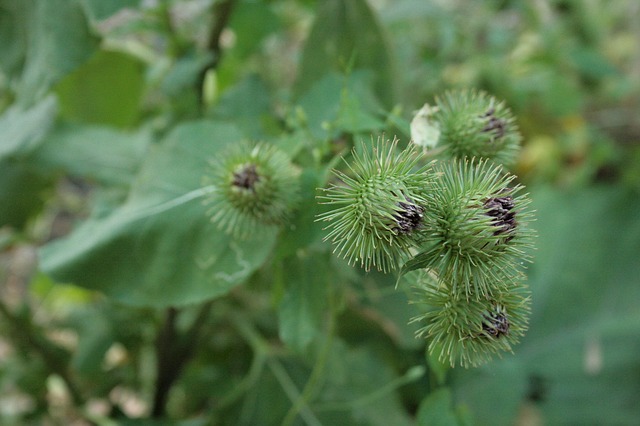 |  |  |  |  |
 |  |  |
Greater Burdock (Arctium lappa) is a biennial herbaceous plant reaching heights of 60–180 cm, with a sparsely branched taproot system. The fleshy root can grow up to 60 cm long. The stem is ribbed, erect, highly branched, and slightly glandular at the top. In the first year, a basal rosette of leaves forms, while in the second year erect stems develop with alternate, broadly ovate, entire leaves that are grayish-woolly underneath and have petioles. The flowers are purplish-violet, tubular, bisexual, grouped in spherical flower heads (30–40 mm in diameter). The pistil has a single-locular inferior ovary, a filiform style, and two linear stigmas. The flower formula of Greater Burdock is *L5T5P2. Fruits are brown achenes with a pappus of short bristles. Flowering occurs from July to August, with fruits maturing from August to September.
Harvesting of Raw Materials
The medicinal raw material consists of the juicy and fleshy roots of burdock from the first year of growth, which are dug up in September–October. The roots are washed with water, then separated from the aboveground parts and cut lengthwise into pieces 10–15 cm long. The roots are dried outdoors or in well-ventilated rooms, and if necessary, finished in drying chambers at a temperature of 45–50°C. Burdock leaves are harvested in July–August and dried in the shade outdoors or in well-ventilated rooms. Seeds are collected as they mature.
Chemical Composition
Burdock roots contain up to 45% inulin and up to 0.17% essential bardane oil; they also include palmitic and stearic acids, sitosterol and stigmasterol, tannins, bitter and fat-like substances, mineral salts, organic acids (such as caffeic, malic, and citric acids), a high amount of protein (up to 12%), sugars, B vitamins, and a significant amount of ascorbic acid. Seeds contain the glycoside arctin and fatty oil (up to 20%). Leaves contain essential oil, mucilage, tannins, ascorbic acid, and carotene.
Pharmacological Properties
Preparations derived from burdock promote rapid tissue regeneration, exhibit choleretic, bactericidal, and antidiabetic effects, and help normalize gastrointestinal function. Burdock roots are used as a diuretic for kidney diseases and edema. They also act as antipyretic and diaphoretic agents in infectious cold illnesses. Burdock is an excellent remedy for restoring metabolism and is used in cases of gout and joint rheumatism. Externally, it is frequently applied to treat skin diseases.
Use in Traditional Medicine
In traditional medicine, burdock roots are used in the form of infusions, decoctions, and tinctures. Ointments made with sunflower oil are applied to ulcers, burns, and bedsores; ointments made with pork fat are used for eczema, acne, urticaria, furunculosis, ringworm, burns, and bites from snakes and bees. Burdock oil is applied for burns, wounds, frostbite, hair loss, and dandruff prevention.
Leaf infusions are used in folk medicine for treating gastric and duodenal ulcers, as well as kidney and liver stones. For wound treatment, juice from fresh young leaves is mixed with crushed leaves and applied to wounds, ulcers, burns, bedsores, and tumors. Decoctions of leaves and flower heads are used in baths for gout and rheumatism, and as compresses applied to painful joints. Seed infusions are used to relieve chronic constipation.
Use in Cosmetics
An aqueous infusion of burdock roots and burdock oil (a root infusion in olive or almond oil) is a traditional and well-known remedy for strengthening hair. However, for hair care and dandruff treatment, the oil infusion of burdock root in almond or olive oil—commonly known as burdock oil—is used more frequently. Externally, burdock oil is applied through scalp massage to treat baldness, hair thinning, and to stimulate hair growth.
